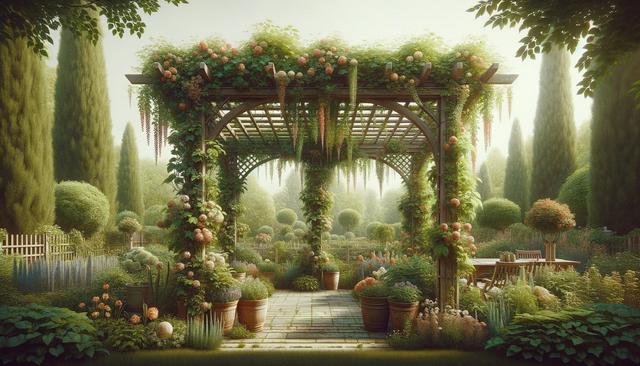Why Use a Garden Trellis?
A garden trellis serves both aesthetic and functional purposes in any outdoor space. It provides essential support for climbing plants, allowing them to grow upward instead of spreading across the ground. This not only saves space but also improves air circulation around the plants, which can help reduce the risk of disease. A trellis can also be a striking visual feature, adding height and dimension to your garden layout. By lifting plants off the soil, it creates attractive green walls or natural dividers between different garden areas. Whether you’re working with a small backyard or a large landscape, a garden trellis can be a smart addition that enhances both the look and health of your garden.
Types of Trellises for Climbing Plants
There are several types of trellises available, each suited for different garden designs and climbing plant varieties. Choosing the right one depends on your space, the types of plants you grow, and the overall style you want to achieve. Common types include:
- Panel Trellis: Flat and often made from wood or metal, ideal for attaching to walls or fences.
- Obelisk Trellis: A freestanding, pyramid-like structure that adds vertical interest.
- Arch Trellis: Great for creating walkways or entrances covered in flowering vines.
- Ladder Trellis: Simple and effective, especially for container gardens or small spaces.
Each type offers unique benefits. For example, an arch trellis can support heavy bloomers like roses, while a panel trellis is suitable for lighter climbers like sweet peas. Consider the mature size and growth habit of your plants when selecting a trellis to ensure they have adequate support.
Best Climbing Plants for Trellises
Not all plants are natural climbers, so it’s important to choose species that will thrive on a trellis. Some popular climbing plants include:
- Clematis: Known for their large, colorful blooms and ability to climb with twining leaf stems.
- Morning Glory: Fast-growing and vibrant, ideal for seasonal color.
- Climbing Roses: Provide classic beauty and fragrance, although some may need tying in place.
- Sweet Peas: Offer delicate flowers and a pleasant scent, perfect for spring gardens.
- Honeysuckle: Attracts pollinators and adds a sweet aroma to the garden.
When planting climbers, make sure to provide them with proper care, including watering, pruning, and training their growth direction. Regular maintenance helps ensure they remain healthy and well-supported on their trellises.
Installing and Positioning Your Trellis
Placement is key when adding a trellis to your garden. The right location ensures your plants get enough sunlight and space to grow. Here are some tips for proper installation:
- Position the trellis where plants will receive at least 6 hours of sunlight per day.
- Anchor freestanding trellises securely into the ground to withstand wind and plant weight.
- Attach wall trellises with brackets or screws suitable for your wall type (e.g., masonry or wood).
- Allow some space between the wall and trellis to promote air circulation and prevent mold.
Before planting, enrich the soil with compost and ensure good drainage. Guide young plants onto the trellis early in their growth to help them establish their climbing pattern. For heavier plants, consider tying stems gently to the trellis with soft ties or garden twine.
Design Ideas and Decorative Uses
A trellis doesn’t just support plants—it can also serve as a decorative feature in your garden design. Depending on the material and style you choose, it can complement various themes, from rustic cottage gardens to sleek modern landscapes. Here are a few creative ideas:
- Privacy Screens: Use tall trellises with dense climbers like ivy or jasmine to create secluded areas.
- Vertical Herb Gardens: Install a small trellis on a balcony or patio and grow climbing herbs like beans or peas.
- Living Walls: Combine several trellises in a grid pattern for a living wall effect filled with flowering vines.
- Garden Entrances: Frame pathways or gates with arch trellises covered in climbing flowers.
Materials like wood, metal, or even recycled items (such as old ladders or window frames) can be repurposed into unique trellises. Painting them in bright or neutral colors can also enhance their visual impact while protecting them from the elements.
Conclusion
Adding a garden trellis for climbing plants is a practical and decorative way to elevate your outdoor space. It allows you to grow vertically, making the most of limited areas while supporting healthy plant growth. Whether you’re aiming to boost curb appeal, create privacy, or simply enjoy the beauty of flowering vines, a well-chosen trellis can help you achieve your garden goals. As you plan your trellis project, consider the type of support your plants need, the placement for optimal sun exposure, and how the structure fits into your overall design. With thoughtful selection and care, your trellis will become a standout feature in your garden for years to come.







